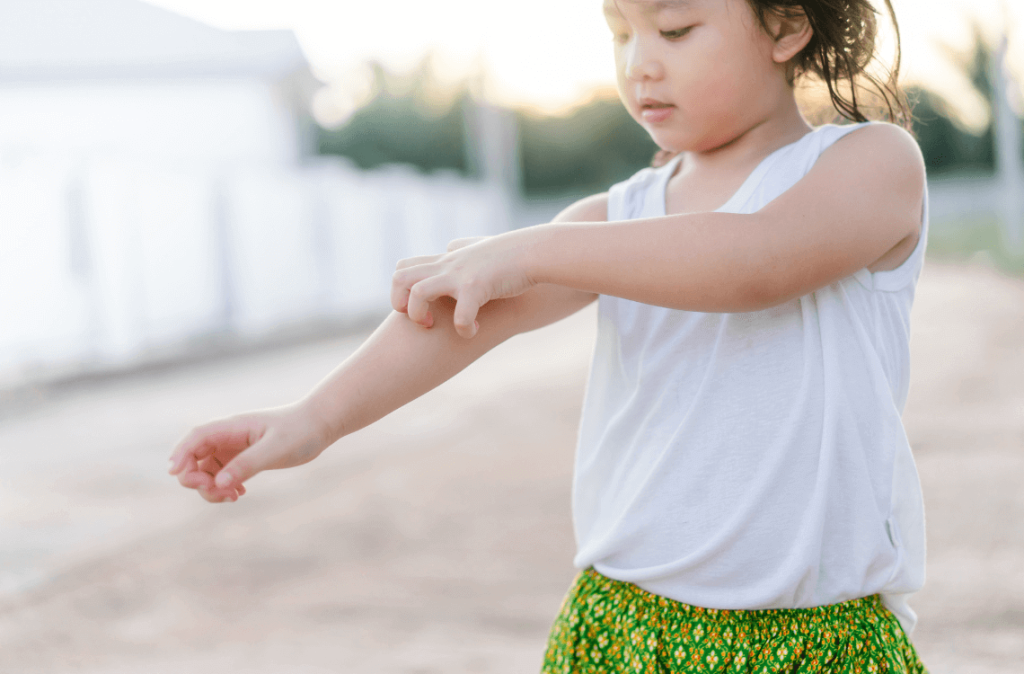Skin allergies are a huge concern for parents, especially for young children.
Skin allergies are generally uncomfortable and can cause symptoms like flaky skin, rashes, hives, bleeding and cracked skin.
Parents need to know what can cause skin allergies and how best to treat the allergy.
So, let’s explore the common causes of skin allergy and the best way to heal children affected by it.
Common Causes Of Skin Allergies
Skin allergies can cause major discomfort for children and there can be many factors that can cause them to occur.
Once you find out what is causing the skin allergy, it will be easier to treat the condition to heal fast.
Soaps
Cleaning products that contain harsh chemicals, fragrances and alcohol should not be used on young children.
Choosing the right soap is crucial as you will be using this product daily.
Soaps that contain harsh chemicals and fragrances may cause rashes, dry skin, eczema, and inflamed skin.
Diapers
Baby and toddlers who use diapers will develop diaper rashes and heat rashes due to sweating and prolonged exposure to excrement.
Parents are encouraged to use diaper creams to avoid diaper rash from occurring.
At times, the baby’s skin might be too sensitive and react to the material of the diaper.
So, it’s best to use a diaper that agrees with your child with diaper cream.
Food Allergies
Food allergies can be unpredictable as you can be unsure of what your child is allergic to.
Doctors recommend blood tests or allergy testing to confirm what kind of foods can cause an allergic reaction in a child.
Common foods that cause allergic reactions are nuts, dairy, some fruits and gluten.
It’s best to keep track of what your child eats so that if a reaction happens, you can trace what caused it.
Allergens in the Air
Dust, animal dander and plants can cause skin reactions, especially for young children since they are more sensitive than adults.
Hives can appear if the child is allergic to animal dander or grass. Food allergies may also cause hives.
Dust mites and bed bugs are also harmful and can cause reactions on the skin.
Viral and Bacterial Infections
Viruses and bacteria can cause an allergic reaction to the skin.
Diseases like Hand, Foot and Mouth disease, measles and chicken pox affect the skin and will require medical treatment from a doctor.
Keeping a child’s hands clean by washing them with soap is important to avoid such infections that can occur with contact.
Children with weak immune systems might be prone to developing such infections.
7 Ways to Treat Skin Allergies
The right treatment for a skin allergy can ensure the child heals quickly and in less discomfort.
Grumpy, fussy children are more difficult to handle and it’s best for everyone in the family if the child feels comfortable.
There are many treatment options available for skin conditions but choosing the right treatment depends on what sort of skin allergy the child has.
It’s always best to check with a paediatrician before treating any conditions for the child’s safety.
Fragrance-Free and Gentle Soaps
Use child-friendly soaps that are made especially for children.
If your child has extra sensitive skin, it’s worth going the extra mile to get soaps that are dermatologically tested.
Don’t be attracted by fragrances and cartoon characters when it comes to soaps as you want to avoid using harsh chemicals, preservatives or fragrances on a young child’s skin.
Moisturise
Moisturising the child’s skin is very important as moisture helps to protect against dry skin, flaky skin and eczema.
Try to avoid using extremely hot water during bath times and use child-friendly lotion after the bath the lock the moisture in.
If you use air-conditioning frequently to keep cool, you can also use humidifiers to keep the air moist so it doesn’t dry out the child’s skin.
Medications and Creams
If your child has developed a skin allergic reaction that seems serious, there are over-the-counter medications like antihistamines, calamine lotion and topical creams that can help the skin to heal.
It is advisable to check with a doctor or pharmacy if such medications or creams can be used on a young child.
It’s important to note that many treatments can’t be used on children younger than 2 years.
Keep Nails Short
Babies are prone to cutting and scratching themselves with their fingernails.
Cut their nails short and use mittens to protect their delicate skin and eyes.
Scratches and cuts can easily get infected without proper care and might cause other health issues.
Be Gentle
Be gentle when cleaning the skin when it’s affected by allergies.
Conditions like cradle caps can get worst if it’s removed roughly and can get infected.
Try to be as gentle as possible and use soft clothes to clean your child so the discomfort and condition can be controlled.
Avoid Certain Foods
Remove food that causes allergic reactions in your child.
If dairy causes your child to have an asthma attack, it might also cause an allergic reaction to the skin.
Try to replace the food that’s causing the allergic reaction with more suitable options.
Be Vigilant
Keep an eye on what your child eats, drinks, wear and touches when possible.
If you are in an environment where they might be exposed to bacteria or viruses that aren’t found at home, try to keep them safe by using sanitisers and limiting the things they touch.
Try to instil the habit of washing hands at home as well so they can be safer outdoors.
Skin Allergies, Scary Initially But Manageable
Parents, don’t fret too much when your child experiences a skin condition.
Be prepared beforehand by doing adequate research and keeping track of the symptoms if an allergy occurs.
Lastly, don’t hesitate to bring your child to the doctor if you are unsure of what to do. You’ve got this!
For more insightful stories and fun recipes, stay tuned to Motherhood Story!
